A History of Pop Music
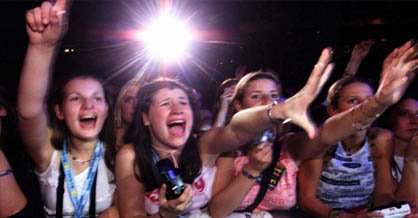
A History of Pop Music
by Geir Hongro
History is crowded with great pop music, but sadly a lot of it is often terribly
overlooked in Rock History books. This is meant as simply a chronological overview of
where to spot good melodic pop music, and it is then quite logical I start with the
early years:
The Pre-Beatles years:
In the years before Beatles we have to go back to Tin Pan Alley ( a name givin to
broadway show area of NYC, ) composers such as Cole Porter and George
Gerswin to find someone willing to go beyond stardard songwriting formulas and
write original and wonderful pop songs. In the early 50s Tin Pan Alley was generally
boring and it is understandable that something new was needed, which is why rock
broke through.
Pop in some way made a partial revenge in the late 50s with the Brill Building in
NYC now the centre. Songwriters such as Neil Sedaka wrote a couple of nice pop
song. Pop pundits may also find some musical interest in the recordings of Everly
Brothers, Roy Orbison and Buddy Holly. Still the best pop records
of the late 50s/early 60s were mainly done by black artists. Sam Cooke is one
of them. His songs such as "You Send Me" and "Only Sixteen" are great pop songs.
Later there were Drifters, an Atlantic soul vocal group that did some nice pop
songs. Singer Ben E. King did even better things on his own: You just HAVE to
like songs such as "Spanish Harlem" and "Stand By Me".
The Beatles and British Beat music

As probably a lot of pop pundits will agree
the story of good pop didn't start for real until the arrival of The Beatles.
I will go as far as say you are no real pop fan unless you have all - and I said
ALL of the Beatles albums. Beatles, simply stated, made pop better
than pop has ever been made before or since. Already from the start there was
something completely new about them, and songs such as "From Me To You", "She Loves
You" and "I Want To Hold You Hand" all changed the way pop was supposed to sound
forever. After that they became more and more adventurous.
"A Hard Day's Night" is one of the best pop albums ever made, with classics all
over. "Rubber Soul" is an exciting journey into folk rock terrotory while "Revolver"
and "Sgt. Pepper" are so adventurous and innovating while still keeping the ear for a
great pop tune". They said goodbye with "Abbey Road" which was again a huge pop
classic. Without Beatles there would have been no pop the way we know it today.
There also were other British beat groups starting in Liverpool at the same time
Beatles broke through. (The music was often called Merseybeat after the
Liverpool river) Gerry & The Pacemakers achieved great succes with partly
the same style. Billy J. Kramer & The Dakotas, Foursome and
Peter & Gordon were all given Lennon/McCartney songs to make their own
versions of. In fact someone who could donate songs like "Bad To Me" and "A World
Without Love" to other artists just had to have an almost eternal well of pop
classics to drink from.
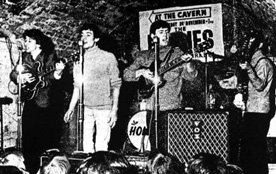 An often underrated 60s British Beat group is
The Hollies. OK, they didn't write their own songs until after the mid-60s,
but they were great singers and songs by writers such as Graham Goldman
sounded terrific when covered by Graham Nash, Allan Clarke et co. Recordings such as
"Bus Stop", "Yes I Will" and "He Ain't Heavy He's My Brother" all sound almost as
great as anything done by the Fab Four, and with "King Midas In Reverse" and the
entire "Butterfly" album they also proved they could be adventurous.
An often underrated 60s British Beat group is
The Hollies. OK, they didn't write their own songs until after the mid-60s,
but they were great singers and songs by writers such as Graham Goldman
sounded terrific when covered by Graham Nash, Allan Clarke et co. Recordings such as
"Bus Stop", "Yes I Will" and "He Ain't Heavy He's My Brother" all sound almost as
great as anything done by the Fab Four, and with "King Midas In Reverse" and the
entire "Butterfly" album they also proved they could be adventurous.
Other great British beat groups were The Kinks (Pure Pop pundits should steer
clear of their very earliest work though), Swinging black Jeans, Manfred
Mann, Freddie & The Dreamers, Dave Clark Five and The
Searchers, all did make some truly great pop stuff.
 Best of all, though, was the often
shamefully overlooked The Zombies (picture right). Their "Oddysey and Oracle"
album from 1968 is IMO one of the best pop albums ever made, but sadly the band had
already decided to break up by then as a result of poor sales and lack of public
acceptance. However a lot of musicians admired them a lot, and now it seems that
people are finally rediscovering their gems (not only "Oddysey and Oracle", but also
such wonderful early singles as "She's Not There" and "Tell Her No"..
Best of all, though, was the often
shamefully overlooked The Zombies (picture right). Their "Oddysey and Oracle"
album from 1968 is IMO one of the best pop albums ever made, but sadly the band had
already decided to break up by then as a result of poor sales and lack of public
acceptance. However a lot of musicians admired them a lot, and now it seems that
people are finally rediscovering their gems (not only "Oddysey and Oracle", but also
such wonderful early singles as "She's Not There" and "Tell Her No"..
Btw. Did you know that even Bee Gees started out making some wonderful melodic pop
singles?
The Revenge Of The US
The British invasion came as a shock to American artists, and it took some time to
recover. Still just a couple of years later America was once more potent to come up
with IMO the greatest period in American pop music ever!

The biggest name was, of course, Beach
Boys, who saw Beatles as their main rivals from the very start. Brian Wilson was
one of The Beatles' greatest admirers, and particularly he was struck by "Rubber
Soul", and set forward to make an even greater album. The result was "Pet Sounds",
definitely one of the greatest pop masterpieces of all time. Later that same year
(1966) they released "Good Vibrations" which was even greater a masterpiece.
But 1966 was not the beginning of Beach Boys. Even before that they were able to
come up with some pop songs most groups could only dream about making. Especially
their vocal harmonies were great, and they definitely inspired a lot of later
pop/power pop groups with those. The earliest real Beach Boys classic I can
think of is "Surfer Girl", which was a song way ahead of its time with its vocal
harmonies, and advanced chord changes.
The mid 60s also brought other great American music. Definitely defining their sound
about the same time as The Beatles were the Tamla Motown record company. With
artists such as Supremes, Temptations, The Four Tops, Smokey
Robinson & The Miracles, Stevie Wonder and Marvin Gaye. 60s
Motown music was great pop with great melodies, and it's only since the late 60s that
too many black artists have been busy with laying down a groove rather than writing a
strong tune.
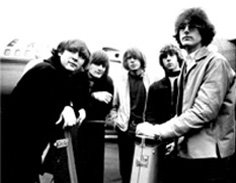
Still the defining thing about American pop music of the 60s was Folk Rock,
and the biggest folk rock name probably was The Byrds (picture left). Their
earliest stuff was a brave attempt at combining the best of the American folk
tradition with the best of the British Beat tradition. They also sang some wonderful
harmonies, and their version of Bob Dylan's "Mr. Tambourine Man" is easily the best
cover version ever done.
Other great folk rock bands of the 60s were The Mamas & The Papas(check
out the hamonies on "California Dreaming"!), The Turtles (underrated but
great) and Lovin' Spoonful. Some of Bob Dylan's work may also appeal to
pop fans.
The Psychedelic Years
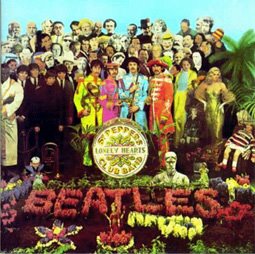 The psychedelic period was a funny time
when a lot of musical experiments were done. Again Beatles were forerunners, as most
of their 1967 ranks among the finest psychedelic music ever. "Sgt. Pepper's Lonely
Heart's Club Band" still wins surveys about the greatest albums ever.
The psychedelic period was a funny time
when a lot of musical experiments were done. Again Beatles were forerunners, as most
of their 1967 ranks among the finest psychedelic music ever. "Sgt. Pepper's Lonely
Heart's Club Band" still wins surveys about the greatest albums ever.
But psychedelic music was also initially highly melodic. Among other things this
meant that some of the hardest rock'n'roll bands suddenly produced some pop gems. An
example is The Rolling Stones, who made a couple of melodic pop albums in
1967. Also the newly formed Buffalo Springfield dropped their blacksiest music
to play some poppy and weird stuff.
Still the psychedelic period also brought the world some new names. Pink
Floyd and Traffic made some funny psychedelic singles just to turn into
more album oriented pop bands afterwards. Procul Harum and The Moody
blacks laid down the basement for what was to become known as progressive rock.
The psychedelic rock soon became more heavy and blacksy (the "psychedelic" and
"experimental" part often focused on new ways of treating guitar sound) and other
styles of music took over as great pop sources.
Bubblegum and Glam
While music became more and more adventurous during the other half of the 60s a
new sort of simple pop music was created for those who didn't want too adventurous
music. It was called Bubblegum and could most easily be described as nursery
rhymes put to a 60s rock/pop backing. Some of it was inspired by psychedelic rock
(some groups used sitar, for instance) while some of it was more similar to early 60s
music.
Some bubblegum acts were simply created by businnes people. One of those was The
Monkees. An American TV company was about to start a new TV series about a band,
and they needed some people to play the band members. The Monkees were given songs by
top songwriters, and some of their early stuff, like "Last Train To Clarksville" and
"I'm a Believer" definitely are quality pop classics. Later they lost their momentum
and turned into a MOR act.
Now a lot of other bubblegum acts turned up. With names like 1910 Fruitgum
Co., Amen Corner, Marmalade, Tommy James & The Shondells
and Ohio Express they came up with some cool pop tunes. Amen Corner were
famous for songs such as "Bend Me Shape Me" and "(If Paradise Is) Half As Nice". Old
Buddy Holly copycat Tommy Roe was possibly responsible for the best song of
all with "Dizzy".
 Some years later UK created its own answer
to Bubblegum. Glam Rock was harder edged and more rock'n'roll than Bubblegum
music, but the melodies were still nursery-rhyme-like. The name Glam Rock came from
how the artists appeared visually (with glam and glitter in their faces), but still
it also had musical components. A lot of Glam Rock is hitlist teen throwaway stuff,
but some of it actually was great pop. Slade, for instance, knew how to come
up with a great pop tune.
Some years later UK created its own answer
to Bubblegum. Glam Rock was harder edged and more rock'n'roll than Bubblegum
music, but the melodies were still nursery-rhyme-like. The name Glam Rock came from
how the artists appeared visually (with glam and glitter in their faces), but still
it also had musical components. A lot of Glam Rock is hitlist teen throwaway stuff,
but some of it actually was great pop. Slade, for instance, knew how to come
up with a great pop tune.
The most important artist of this age still is David Bowie (picture right).
While appearing as a strange angrogynous creature he actually made his best music
ever. His early 70s glam period was when he wrote songs such as "Starman", "Changes",
"Ziggy Stardust", "Life On Mars" and "Drive In Saturday" - all classics of British
pop music. Bowie also helped Mott The Hoople kick off their career, when he
wrote, and sung on, "All The Young Dudes".
Singer/songwriters
The early 70s also were the age of the singer/songwriter. Inspired partly by folk
they had a much simpler approach to music than the typical late 60s musicians. They
mainly wrote their own songs, thoughtful lyrics included, and they were strong on
melody and weak on backing stash. Singer/songwriters such as Carole King,
James Taylor, Paul Simon (initially with Art Garfunkel),
Carly Simon, Joni Mitchell and Don McLean all had their heyday
at this period.
While the singer/songwriter was generally a US phenomenom possibly the greatest of
them all was British. Elton John made some wonderful pop songs during the
early 70s, and noe one else have ever been able to write such beautiful piano based
ballads. Elton John was not completely a fully fledged singer/songwriter,
since Bernie Taupin wrote most of his lyrics, but his melodies (and Taupin's strong
words) are enough to make him a great artist from this period. Elton John's output
may have weakened, and today he is a boring MOR artist, but his early 70s records are
still worth checking out closer.
"Progressive Pop"The progressive rock age was a heavy period filled with
ambitious 20 minute works that don't really belong here. Still some of the
progrockers had an ear for a great melody, and especially Genesis are worth
checking out if you aren't afraid of ambitious music with more to it than just verse,
bridge and chorus. Especially "A Trick Of The Tail" and "Wind And Wuthering" are
filled with wonderful pop tunes.
More important, though, is the so-called "progressive pop" that came out of this
period in UK music. Bands that were mainly pop bands, but still had lots of musical
ambitions, suddenly emerged on the UK 70s scene. Examples were Supertramp,
10cc, Alan Parsons Project and Electric Light Orchestra.
Canadian group Klaatu may also be mentioned here..

10cc (picture above) consisted of four experienced individuals. Graham
Gouldman had been a songwriter with artists such as Hollies, Yardbirds and Herman's
Hermits giving him hits, Eric Stewart had been a member of Mindbenders while Kevin
Godley and Lol Creme had both been doing a lot of production work. Together they set
forward to create a perfect sound, write some great tunes and sing the most wonderful
vocal harmonies since The Beach Boys. Especially their mid-70s work was great. "I'm
Not In Love" is a classic, but if you are into ambitious music album tracks such as
"Don't Hang Up" and "Un Nuit a Paris" are even stronger.
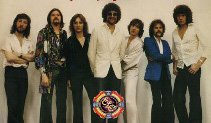 Electric Light Orchestra
Electric Light Orchestra (picture
left) originally were based on UK 60s pop group
The Move. Led by Jeff Lynne
and Roy Wood they intended to keep up where Beatles stopped around 1967, with string
based rock music inspired by "Strawberry Fields Forever" and "I Am The Walrus". Roy
Wood soon left to form throwaway glam band
Wizzard and Jeff Lynne was left to
build up ELO (as they were usually) called on his own. He recruited several string
players plus keyboardist Richard Tandy (Keyboards were to become an important part of
their sound) and started writing wonderful melodic pop tunes with great backing
vocals. During the late 70s they were superstars, thanks to such wonderful albums as
"A New World Record", "Out Of The black" and "Discovery".
Another band that partly belongs in this category are
Queen. They were more
of a rock'n'roll band than the others, but their songs, and their vocal arrangements,
pointed in the pop direction. Queen were even more adventurous than 10cc when it came
to backing vocals and "Bohemian Rhapsody" and the album where it was taken from; "A
Night At The Opera" are true classics that every pop pundit should own. They
continued making great pop until marvellous singer
Freddy Mercury sadly died
far too early from AIDS.
Power Pop
Already in the late 60s some people missed the great pop of the mid-60s. They
didn't want to be adventurous and experimental - they simply wanted to write great
pop songs. This is what led to Power Pop, which can easily be described as
"melodic rock'n'roll".
While Power Pop has mainly been an American phenomenon one of the early great Power
Pop groups was The British group Badfinger. They were on The Beatles'
recording label Apple, and musically they compared a lot to The Beatles, except they
had a harder edged sound. Songs such as "No Matter What" and "Come On And Get It" are
considered classics among most US pop pundits, as is "Without You", a song that was
actually more famous by Nilsson. Several central members of Badfinger tragically
suffered untimely deaths.
Another important early-70s Power Pop band was Raspberries. Led by Eric
Carmen they initially sounded a lot like The Beatles. The band didn't last very
long and Eric Carmen continued recording on his own. In 1977 the classically trained
Carmen had a major hit with "All By Myself", a hit that was partly built on a piece
by Rachmaninov.
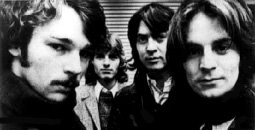 The third of the great early Power Pop
groups were Big Star (picture right). Led by pop legend Alex Chilton
they didn't sell that many records at once, but has since become legends and
important inspiration sources for almost any Power Pop band that was to follow.
"September Gurls" was their most famous song and has become a pop classic.
The third of the great early Power Pop
groups were Big Star (picture right). Led by pop legend Alex Chilton
they didn't sell that many records at once, but has since become legends and
important inspiration sources for almost any Power Pop band that was to follow.
"September Gurls" was their most famous song and has become a pop classic.
Also partly a Power Pop artist was Todd Rundgren. More occupied with trying
to find the perfect sound than the others Todd Rundgren made some wonderfully
produced melodic rock'n'roll, most well-known from his "Something/Anything" double
album.
As the 70s went more Power Pop groups appeared, most of them American. Among the
other important Power Pop names of the 70s were Flamin' Groovies, Cheap
Trick, 20/20 and The Knack. The latter group had a huge hit in the
US with "My Sharona" in 1979.
From Pubrock to New Wave
The UK Pubrock scene was in many ways quite similar to the US Power Pop
scene. The Pubrockers objected against the complexity of psychedelic and progressive
rock and wanted to make more simple melodic rock'n'roll. The leading bands among the
pubrockers were Ace and Brinsley Swarz, and those two bands were led by
respectively Paul Carrack and Nick Lowe, both of whom became important
figures in the UK 70s pop scene.
New Wave is often described as a more "sophisticated" version of punk, but
the fact is that besides an obvious reggae inspiration New Wave first and foremost
builds on the Pubrock heritage: Simple, melodic pop songs backed by power chords. The
before mentioned Lowe was one of the people behind what was to become the New Wave
sound, with songs such as "I Love The Sound Of Breaking Glass", "So It Goes", "Little
Hitler" and "Cruel To Be Kind".
Elvis Costello & The Attractions appeared on the scene in 1977 and has
since continued to provide the world with great pop music. Songs such as "Oliver's
Army", "Accidents Will Happen", "Clubland", the wonderful ballad "Shipbuilding" and
later gems such as "Veronica" and "The Other Side Of Summer" are all the sort of
songs that will delight any pop fan.
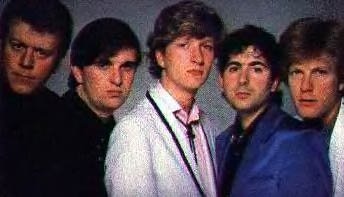 Anyway the New Wave group that more than
anyone else were the favourites of pop pundits were Squeeze (picture left).
Obviously inspired by the Fab Four they made some truly great pop classics. Titles
like "Cool For Cats", "Up The Junction", "Tempted" and "Pulling Mussels From The
Shell" were all among the greatest pop stuff you could possibly find in the late
70s/early 80s.
Anyway the New Wave group that more than
anyone else were the favourites of pop pundits were Squeeze (picture left).
Obviously inspired by the Fab Four they made some truly great pop classics. Titles
like "Cool For Cats", "Up The Junction", "Tempted" and "Pulling Mussels From The
Shell" were all among the greatest pop stuff you could possibly find in the late
70s/early 80s.
Other New Wave groups that are worth checking out for pop fans were The Boomtown
Rats, Undertones , US Powerpoppers/New Wavsters The Cars, some
stuff by Tom Robinson Band, Graham Parker & The Rumour and Ian
Dury. The earliest stuff by XTC may also be put in the New Wave
category.
The UK Ska movement also has to be mentioned here. It started out as a punky,
and rather lo-fi try at mising together reggae and punk, but ended up in some tryly
sophisticated records. At least compilations by Madness and Specials
should be in any pop music record collection. Specials member Terry Hall later
formed Fun Boy Three and Colourfield before he ended up as a highly
underrated and recommended solo artist.
New Romantics
 If you don't like synths you may as well skip
this whole chapter, because the UK early 80s New Romantics craze
definitely was about synths - synths, music video and image. But New Romantics
also was about great melodic pop songs, and groups such as Spandau Ballet,
Simple Minds, ABC, Culture Club, Japan, Thompson
Twins(picture right) and even teenyboppers Duran Duran made some songs
worth checking out.
If you don't like synths you may as well skip
this whole chapter, because the UK early 80s New Romantics craze
definitely was about synths - synths, music video and image. But New Romantics
also was about great melodic pop songs, and groups such as Spandau Ballet,
Simple Minds, ABC, Culture Club, Japan, Thompson
Twins(picture right) and even teenyboppers Duran Duran made some songs
worth checking out.
Even more interesting (again if you don't hate synths) were the plain synthpop
groups. Human League made one of the best albums ever with "Dare", Depeche
Mode and Yazoo followed to make Daniel Miller, the man behind indie label
Mute, rich. Orchestral Manouvers In The Dark, Visage, Soft Cell,
Ultravox and Human League-spinoffs Heaven 17 also made some great pop
records. Vince Clarke, once a member of Depeche Mode and then Yazoo, later
formed Erasure, a band that still exists and has had more success than Yazoo.
There even was an American synthpop band, the slightly more musically eccentric
Devo. After some time a more musically sophisticated, and not that entirely
synth based, sort of synthpop was developing. Artists such as Talk Talk,
Tears For Fears and Howard Jones represented this new trend.
Underground Pop
During the 80s an "underground culture" was building itself up within the music
audience. While most of those underground bands were typical rockers some pop music
also started being released on small labels. In the early 80s this was mostly guitar
based pop as most mainstream pop was keyboard based, but later also some keyboard
based stuff had a large underground audience.
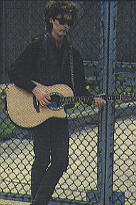 One of the very first
underground pop labels were the Glasgow based Postcard label. One of their
bands were Aztec Camera, who were in reality Roddy Frame (Picture
left). He debuted with the album "High Land Hard Rain", a wonderful album that was
IMO the best debut album that has ever been released. After that he never quite
managed to follow it, although "Dreamland" from 1993 was a great album. The Postcard
label also had some other great pop artists, such as Orange Juice (led by now
succesful solo artist Edwyn Collins) and Paul Haig
One of the very first
underground pop labels were the Glasgow based Postcard label. One of their
bands were Aztec Camera, who were in reality Roddy Frame (Picture
left). He debuted with the album "High Land Hard Rain", a wonderful album that was
IMO the best debut album that has ever been released. After that he never quite
managed to follow it, although "Dreamland" from 1993 was a great album. The Postcard
label also had some other great pop artists, such as Orange Juice (led by now
succesful solo artist Edwyn Collins) and Paul Haig
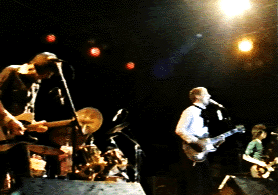 Even more important than what happened on
Postcard was XTC (picture right). This innovative and eccentric, still highly
poppy and melodic band started out as some sort of New Wave/Power Pop outfit, then
changed into a more "sophisticated" pop style. They were inspired by late 60s
psychedelic pop. On their later albums they have dropped their original low fi
profile to come up with possibly an even better sound. "Skylarking" from 1986 is IMO
one of the best albums ever made.
Even more important than what happened on
Postcard was XTC (picture right). This innovative and eccentric, still highly
poppy and melodic band started out as some sort of New Wave/Power Pop outfit, then
changed into a more "sophisticated" pop style. They were inspired by late 60s
psychedelic pop. On their later albums they have dropped their original low fi
profile to come up with possibly an even better sound. "Skylarking" from 1986 is IMO
one of the best albums ever made.
Two other important bands/solo projects just had to be mentioned. Scritti
Politti in reality soon turned out to be Green Gartside using a band name.
He made some interesting reggae/jazz funk inspired music and "Cupid & Psyche"
from 1985 contained a lot of great tracks including the hits "The Word Girl" and
"Perfect Way". The latter was covered by Miles Davis, which should be seen as a great
honour. Possibly more of a band than Scritti Politti was Prefab Sprout
although Paddy McAllon was the lead singer, songwriter and undisputed leader.
Their records are harmonically very advanced, but still highly catchy. Their
"Jordan...The Comeback" from 1990 is a great concept album that in lots of fans'
opinion represents the highlight of their career.
 Down under, in Te Awamutu, New Zealand,
Split Enz (picture left) was started in the early 70s. After making some truly
quirky prog rock inspired records during the 70s they turned into a more Power
Pop/New Romantics inspired sound. The band was led by brothers Tim and Neil
Finn, and any of their early 80s albums are worth checking out for pop fans. Big
brother Tim left for a solo career in 1984, and after one more album Neil disbanded
the group to form Crowded House
Down under, in Te Awamutu, New Zealand,
Split Enz (picture left) was started in the early 70s. After making some truly
quirky prog rock inspired records during the 70s they turned into a more Power
Pop/New Romantics inspired sound. The band was led by brothers Tim and Neil
Finn, and any of their early 80s albums are worth checking out for pop fans. Big
brother Tim left for a solo career in 1984, and after one more album Neil disbanded
the group to form Crowded House
Other important "sophisticated underground pop artists" of the 80s were Thomas
Dolby (who also produced Prefab Sprout), The black Nile, The The
and Danny Wilson among others.
Ex-Japan singer David Sylvian could also possibly be put in this category
except he is a lot more experimental than a lot of pop pundits would probably
swallow.
80s Power pop
The US Power Pop movement was somewhat unfashionable during the 80s, and the best
American pop songs you could find on the hitlists were possibly those by girl groups
such as The Go Gos and The Bangles.
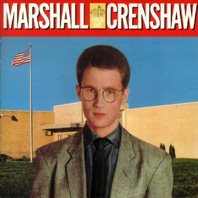 Still this didn't mean that good American
(Power) pop didn't exist during the 80s. You just had to dig a bit down into the
underground to find it. Great US Power pop was still done by artists such as
Marshall Crenshaw(picture right),The Spongetones, Phil Seymour
and The Romantics.
Still this didn't mean that good American
(Power) pop didn't exist during the 80s. You just had to dig a bit down into the
underground to find it. Great US Power pop was still done by artists such as
Marshall Crenshaw(picture right),The Spongetones, Phil Seymour
and The Romantics.
Some AOR-type bands also did great pop records, most important of which were The
Cars. Another 80s AOR artist that some pop pundits may like is Australian Rick
Springfield.
British Indie
Indie originally means "independent", which means the music was released on
independent labels. Still "indie" since the mid-80s also have been used to describe a
particular type of music, mainly British guitar based underground pop. While some 80s
indie stuff may be more rock than pop there still were indie groups that did some
good pop tunes. The Smiths, The Cure and Echo & The Bunnymen
are all examples of British 80s indie groups that at times write/wrote great pop
songs.
After some time indie evolved into baggy, which comes of the big clothes
those artists used to wear. Baggy started in Manchester during the late 80s and was
mainly some sort of compromise between indie pop/rock and the new dance music. Baggy
started as a Manchester thing and the leading baggy group were The Stone
Roses. Some baggy artists were heavily into rap and dance, in such a way the
melodic aim disappeared from their music. Still a lot of baggy bands made great pop
music, among those were The Charlatans, The Mock Turtles and the
earliest stuff by Blur.
Some more British indie bands have to be mentioned here, as they all made some
wonderful 60s inspired stuff that pointed towards what was later to become known as
Britpop. Particularly all lovers of good pop should check out The Wonder
Stuff. Their song "Size Of a Cow" is among the great British indie classics. Also
The La¨s and, a little later; Ride made some wonderful melodic pop
songs in an indie style.
Totally "Unfashionable"
At the turn of the decade making melodic quailty pop was just about as "unhip" as
you could possibly get. The "hip" people loved rap and house music, possibly the
least melodic and "poppy" styles of music ever in rock history. Still some people did
exactly what they wanted to without caring too much about what's hip or not.
One of those people was Karl Wallinger. He used to be a member of The
Waterboys, but split early to start his own band World Party. World Party
based their sound mainly on 60s folk rock combined with some British beat and a
little dash of funk, of course all pretty melodic. "Goodbye Jumbo" from 1990 is a
highly recommended album.
Even bigger was Oz band Crowded House. Started by ex-Split Enz-members Neil
Finn and Paul Hester Crowded House made some truly wonderful songs, given truly
tasteful arrangements. All their three last albums are classics, particularly
"Woodface" from 1991, where also big brother Tim Finn guested as band member for a
short time. They split up in 1996, which was pretty sad to their fans. A lot of
people will proably rank Crowded House as the best pop group of the late 80s/early
90s.
A bit similar to Crowded House were US group Jellyfish. Some people would put
them into the Power Pop category, but in that case they were definitely more pop than
power. Most of all Jellyfish was beautiful harmonic pop music.
In the late 80s UK producer/songwriter Ian Brouide finally started making
records on his own. Broudie had been a member of UK Big In Japan together with later
stars such as Bill Drummond (KLF) and Holly Johnson (Frankie Goes To Hollywood), but
in 1989 he released his debut single "Pure" under the name Lighning Seeds. The
music was melodic pop, filled with harmony. It was wonderful and as far from house
music as you could possibly come. Brouide started some sort of underground movement
for melodic pop, and he also discovered some other melodic acts.
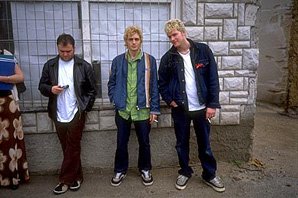 One of those were Dodgy (lef).
Sounding a lot like The Hollies Dodgy wrote songs as strong as the ones
written by Crowded House/Split Enz. They also sang some wonderful backing vocals.
"Staying Out For The Summer" still is among my favourite 90s singles. "Homegrown" and
"Free Peace Sweet" were brilliant albums, and Dodgy is the recent group to
check out!
One of those were Dodgy (lef).
Sounding a lot like The Hollies Dodgy wrote songs as strong as the ones
written by Crowded House/Split Enz. They also sang some wonderful backing vocals.
"Staying Out For The Summer" still is among my favourite 90s singles. "Homegrown" and
"Free Peace Sweet" were brilliant albums, and Dodgy is the recent group to
check out!
With Britpop making good old fashioned pop songs once more fashionable both
Lightning Seeds and Dodgy have had big hits in the UK. (Lightning Seeds even topped
with "Three Lions"). But making "unfashionable" music is still possible, which is
proved by The High Llamas, the brainchild of Sean O'Hagan. Like ELO
originally tried to build their sound on "I Am The Walrus" and "Strawberry Fields
Forever" The High Llamas rather use "Pet Sounds"-era Beach Boys as a musical role
model, which has lead to two great, perfectly produced and highly original
albums.
Britpop explodes
Sometime around 1993-94 the past suddenly became very important indeed for British
indie bands. It seemed the point was to collect the best of British pop history and
turn the whole thing into a style of music that was more British sounding than
anything since British Beat.
Although the mentioned British Beat has been important the first big Britpop band
took most of their inspiration from 70s glam rock. Suede were "the next big
thing" in 1993, and their self titled debut album got rave reviews all over in
British newspapers. For "poppers" their 1996 album "Coming Up" is probably the best
Suede album though.
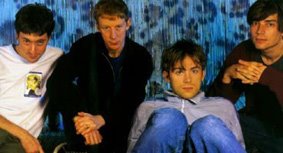
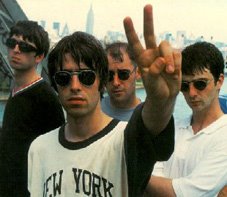
Shortly after Suede Blur(left) were kings of British indie pop. When they
released "Parklife" in 1994 they also broke through to a wider audience than most
British indie bands would normally do. "Parklife" was an album that draw inspiration
from almost the entire British pop history, but particularly from The Kinks. . That
same year Oasis (right) also released their debut album "Definitely Maybe".
Oasis were(and still are) led by two brothers, singer Liam and songwriter
Noel Gallagher. They often spoke to the press about how much they love The
Beatles, but they also spoke about how much they hated Blur, which led to some kind
of "band war".
The autumn after the two groups released a single on the same day. Blur debuted at
UK#1 with "Country House", while Oasis debuted (and stalled) at UK#2 with "Roll With
It". Thus Blur won the first round of the "band war" that had meant a lot of
important publicity for both of them. Later Oasis released "Wonderwall", a much
bigger worldwide hit than Blur had ever had (including huge US sales) and it seemed
that while Blur won the UK band war Oasis had won the US thing.
When Pulp also became quite huge that autumn the press decided a name for the
style, and that's when Britpop was born. The Britpop age was a wonderful time
for pop fans, because it meant that once more melodic pop music was hip. Records by
artists such as Kula Shaker, Ocean Colour Scene, Gene, The
blacktones, Sleeper and Supernaturals meant reason to be happy once
more for most pop pundits, at least us in European countries where most of those
wonderful British records were released.
One group that deserves a special mention here is Super Furry Animals. This
Welch group has developed a somewhat more experimental and psychedelic sound than the
other bands, which still means they often are even better than the others. Their
recent concept album "Radioator" is better than most other Britpop albums ever
released.
Power Pop returns
At a time when retro was dominating the British charts before or since the same
retro/melody/pop thing had to move to the US, and it did in the mid-90s, by once more
bringing Power Pop up from the underground. The new generation US power poppers
partly based their sound on typical 90s grunge-like ideals, but the melodies and
harmonies were the same wonderful ones.
 Among the main names in 90s American
Power Pop are Lemonheads, Gigolo Aunts, Red Kross,
Posies, Wondermints and Matthew Sweet (right). Matthew Sweet has
been making records since the mid-80s, but it's only recently he is being discovered
for real. His recent "black Sky On Mars" album has received rave reviews just about
everywhere, and he is celebrated as some kind of "King of 90s Power Pop".
Among the main names in 90s American
Power Pop are Lemonheads, Gigolo Aunts, Red Kross,
Posies, Wondermints and Matthew Sweet (right). Matthew Sweet has
been making records since the mid-80s, but it's only recently he is being discovered
for real. His recent "black Sky On Mars" album has received rave reviews just about
everywhere, and he is celebrated as some kind of "King of 90s Power Pop".
The recent success of Power Pop has also led to labels searching for bands to
promote and turn into huge stars. It seems that Elektra found one of those when they
signed Third Eye Blind, a grunge-inspired Western Power Pop band, and thanks
to the commercial success of singles such as "Semi Charmed Life" they may well be
labelled the Knack of the 90s.
Still also when it comes to Power Pop the Brits are at the time probably even better
than The Americans. Power Pop veterans on the British scene are Teenage
Fanclub. Their lojal fanbase has grown bigger and bigger for each album, and this
year's "Song From Northern Britian" has to some extent led to them getting some of
the kind of success they long since deserved. Those who know their older work know
that "Grand Prix" is possibly even better.
The most recent addition to the UK Power Pop scene are Silver Sun. With hard
fuzz guitars, Beach Boys-like vocal harmonies and strong songs they have made on of
the better records of 1997 with their self titled debut album.
And this means we are at the end. We are now talking about today's music. Let me
therefore add that besides Power Pop/Britpop Ben Folds Five is an American
band worth checking out. Radiohead's "OK Computer" probably also appeals to
pop pundits the way it has appealed to surprisingly many music fans around the world.
By adding their "The Bends" from 1995 was also a wonderful album I simply stop here.
What a wonderful world of pop it is?!!!!!
PageTOP ^
Disclaimer
The Roots of Rock 'n' Roll
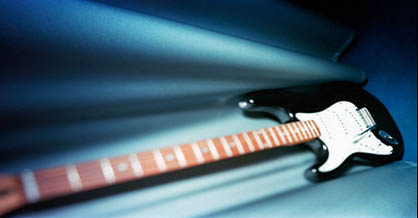
by Jack Madani
In 1945, World War II ended.
By 1946, American servicemen began returning home to start up the
families they had had to put on hold for 4 years. Thus began the
unusually large bubble in the population curve of America known as
the Baby Boom, as gazillions of babies were born all of a sudden in
the span of five to ten years. Remember that all those babies born in
1946-1947 would be 18 in 1964-1965 (and eventually 22 and out of
college, and into the marketplace in the early '70's, to kick off the
Me Decade). What that means is that American society would suddenly
find itself catering to a generation of young people in a way that
had never occurred before.
Sixties rock finds its roots in several places, starting as far back
as the big swing bands of the pre-war era that the 60's kids' parents
listened to as youngsters: Glenn Miller, Benny Goodman,
Count Basie, Tommy and Jimmy Dorsey, and Duke
Ellington's bands are some of the most famous. Except for Duke
Ellington, all those bands were primarily dance bands, with big
swinging backbeats. You can still hear some of their greatest hits
today in such unusual places as the Chips Ahoy commercial (1,000
chips in every bag).
There were also the smaller, "rhythm combo" groups, usually of only
four or five players. Their tunes were popular on the jukeboxes of
the day, but were not considered artistically important which is why
we have mostly forgotten them today. The recent Broadway show "Five
Guys Named Moe," which highlights the career of Louis Jordan, tells
about one of the most popular rhythm combos of the day. Nat King
Cole also had a small jazz combo that had popular success, before
he became a Sinatra-style pop ballad singer in the '50's.
Then there was Country & Western--especially what was called
"Texas Swing," of which Bob Wills & the Texas Playboys was
the king. Hank Williams Sr. was another important
singer/songwriter of that era and genre.
Over in Memphis there was Sam Phillips and his Sun Studios,
where rockabilly and Elvis Presley were born. Besides Presley,
Jerry Lee Lewis, Carl Perkins, Johnny Cash and
Roy Orbison all began their recording careers at Sun
Studios.
Two other sources of modern rock'n'roll, absolutely essential to the
sound we think of as 60's rock, were, first, the blacks.
blacks began as the music of black sharecroppers in the poor
cotton-farming region of the Mississippi Delta, and traveled north to
Chicago with the sharecroppers as thousands of them moved north in
search of a better life. It was in Chicago that the blacks went from
acoustic solo guitar music to electric guitar-electric bass-drums
combos. Muddy Waters, Little Milton, B.B. King,
and Howlin' Wolf were just a few of these important Chicago
blacks artists.
The last source of modern rock'n'roll is actually a single man.
Les Paul was a studio whiz and guitar player who designed the
Gibson Les Paul electric guitar, and pioneered the technique of
overdubbing, allowing one person to play more than one part on a
recording. Working with his wife Mary Ford, who sang the vocal parts,
Les Paul created a series of two-person recordings that sounded like
an entire band was playing--and the music was all guitar-based.
The 1960's Begin:
As the late fifties gave way to the early sixties, the rockabilly
stars of the previous decade (the Everlys, Elvis,
Roy Orbison) were still having hits, but the older pop-music
stars were fading away as they struggled to find material that would
click with this new and energetic generation of kids. Pop music
gradually became controlled by new young "vocal"-groups, taking their
power from a combination of the performer's charisma along with the
songwriting talents of the production team, who operated behind the
scenes. Eventually rock artists came to be expected to write and even
produce their own songs, becoming responsible for everything about
how their records sounded--but that would have to wait for Marvin
Gaye, Brian Wilson and Lennon & McCartney.
In general there were four main pockets of early 60's pop:
the East Coast DooWop and girl groups were singers and
groups whose origins are in the streetcorner a cappella groups found
in many urban centers. With very rare exceptions, these groups did
not write their own songs, but relied on their handlers to set up the
recording sessions, pick the material, and produce the records. In
fact, many of these behind-the-scenes people eventually became stars
in their own right in the seventies.
The R&B and Soul scene included many talented
people who often didn't receive the popularity of less-talented white
groups, because of barriers and prejudices against buying "race"
records. Later in the decade, after the British groups acknowledged
their debt to soul music, and as the civil rights movement inspired
black pride, the general American public rediscovered these
performers.
the California scene was first dominated by instrumental
surf groups like the Surfaris, the Crossfires, and
Dick Dale & the Del-tones. Dale, the "King of Surf
Guitar," in particular helped define how modern rock guitar solos
would sound. Then the Beach Boys added vocal harmonies to the surf
sound. This surf-&-drag, fun-in-the-sun sound was so popular that
the style showed up all over the place, even in tv theme songs such
as the Munsters and Hawaii Five-O. But the real important stuff was
happening in the recording studios, where young studio wizards like
Brian Wilson, Phil Spector, and the team of Sloan
& Barri began turning the studio itself into their
instrument, looking for new sounds in a quest not for records but for
productions. There were studio svengalis back east, too, including
Bob Crewe and the team of Burt Bacharach & Hal
David. Modern artists like Prince, Lindsey Buckingham, and Jimmy
Jam & Terry Lewis who use synths and samplings, are rather like
the spiritual descendants of those white suburban teenagers, taking
their distinctive sound with them regardless of the particular artist
they happen to be working with.
The Motown record label in Detroit was founded by Berry
Gordy Jr., and while its recording stars were all black, still you
couldn't necessarily call this totally black or "soul" music. Instead,
Gordy controlled the performing styles, clothes, even hairdos of his
artists, grooming them for success in the wider mainstream (read
white) American audiences. The label's slogan, "the sound of young
America," and their nickname, "Hitsville USA" point to the wide net
that Motown attempted to cast. Among the many successful performers
who recorded for Motown, one ought to mention Marvin Gaye, who
was first to take control of his own career and insist on artistic
control over his recordings. Later Stevie Wonder and Smokey
Robinson would also prove to be outstanding writers and
producers, but Marvin Gaye was the first at Motown.
The British Invade:
With 1963 comes the end of rock'n'roll and the beginnings of "rock."
Of course, in 1963 John Kennedy was assassinated, and his vice
president Lyndon Johnson was sworn in as president. Soon LBJ
escalated the United States' involvement in Viet Nam and declared war
on poverty as part of his Great Society program, a systematic
widening of the government's powers that required higher taxes and
spurred ruinous inflation. Meanwhile, the televised police beatings
of members of Martin Luther King's nonviolent Civil Rights movement
made it plain to many people that the powers that be were not
necessarily interested in protecting people's human and
constitutional rights. Thus it wasn't long before the youth of
America was finding itself deeply questioning its country's leaders.
A large part of the innocence went out of pop music. And then came
the British.... The Beatles were merely the most visible of
the many British music acts that found success in America in the
mid-60's. Many people count the Fab Four's landing at La Guardia
airport on February 7, 1964, and their performance on the Ed Sullivan
Show a week later, as the official beginning of what came to be
called the "British Invasion." The Beatles were hugely popular; at
one point they had the top five records on the Billboard Hot 100
list. Their sound and attitudes influenced everything that came
afterwards--even today, when kids sing along with pop tunes on the
radio and sing soft Britty "r's", they're unconsciously mimicking the
English sound. Like the killer meteor that caused mass extinctions 65
million years ago, clearing the way for a whole new evolutionary path
based on mammals instead of reptiles, the British Invasion killed off
almost all the existing American groups (only the Beach Boys, Four
Seasons, and the biggest Motown acts managed to survive). In their
place rose up all sorts of American groups who dressed and sounded
just like the Brits, as for instance the Knickerbockers,
Beau Brummels, Buckinghams, Sir Douglas Quintet,
and Turtles--before the Turtles became famous they used to
hang out at bowling alleys and order tea with plenty of milk,
speaking in fake English accents and trying to pass themselves off as
Gerry and the Pacemakers. Then the folkies went
electric. For this the great turning point was 1965, at the Newport
Folk Festival. Bob Dylan turned up to perform with an electric
guitar, and was practically booed off the stage, but he had shown the
new path for folk music. And the Byrds had their first big hit
with Dylan's "Mr. Tambourine Man," using that record to show how
folkie songs could be built on a Beatle-esque sound (the first time
group founder Roger McGuinn saw the Beatles on tv, he went
right out to buy a Rickenbacker 12-string guitar just like George
Harrison's). From Songs to Productions: Rock'n'Roll's death and the
Birth of "Art Rock": The next two years, from 1965 to 1967, saw the
most amazing experiments and changes in rock music ever. The simplest
way to watch those changes is to review the back and forth record
releases by the Beatles and the Beach Boys, perhaps the two most
innovative recording groups of the mid 60's. Back in 1964, these
groups produced such fun energetic pop as:
| BEATLES |
BEACH BOYS |
| A Hard Day's Night |
I Get Around |
By 1965 these groups became more studio-oriented and less
interested in performance-friendly songs. Brian Wilson of the
Beach Boys had a nervous breakdown while on tour at the
beginning of 1965, so he stopped touring and concentrated on working
in the studio. John Lennon and Paul McCartney of the
Beatles also became more interested in the production angle,
collaborating more with their longtime producer George
Martin.
| BEATLES |
BEACH BOYS |
| Norwegian Wood (This Bird Has
Flown) |
God Only Knows |
| Michelle |
Pet Sounds |
In 1966 the Beatles announced that they would no longer
tour at all and retired full-time to the recording studio. John was
particularly interested in using recording tricks in Beatles songs,
and the subject matter of their songs was becoming more and more
openly radical. Brian, meanwhile, was now working completely
with studio musicians, often using 25 musicians at a time in
what was in effect the first rock-orchestra. He stopped writing songs
in the traditional manner, instead "constructing" songs out of
recorded bits and pieces (pre-dating Todd Rundgren's recent
forays into "interactive music" by 25 years).
| BEATLES |
BEACH BOYS |
| Eleanor Rigby |
Good Vibrations |
| Love You To |
Heroes and Villains |
| Tomorrow Never Knows |
Cabinessence |
1967 saw the release of the Beatles' Sgt. Pepper's Lonely
Hearts Club Band, and the Beach Boys' Smiley Smile. Sgt.
Pepper was a complete and revolutionary album, full of weird effects
and songs about drugs. Smiley Smile was also a revolutionary album,
full of weird effects and songs about drugs. But it was not a
finished album. Brian went through another breakdown, this time
caused by LSD, and the album he released wound up a pale imitation of
what he had intended to produce. Sgt. Pepper became the anthem for
1967's "Summer of Love;" it was the height of flower power, arty
progressive music that seemed to influence the social fabric, and of
the youth movement's naive sense that a new age was about to
dawn.
| BEATLES |
BEACH BOYS |
| Lucy In the Sky With
Diamonds |
Fall Breaks and Back to
Winter |
| Within You Without You |
Wind Chimes |
| A Day In The Life |
Vegetables |
1968 & 1969: The Unraveling:
No sooner had 1967's "summer of love" passed than it all started to
come undone in 1968. In that year both Robert Kennedy and Martin
Luther King were assassinated. LBJ had so escalated America's
involvement in the Viet Nam conflict that across the nation's
campuses students were rioting, while the "war on poverty" seemed to
be going nowhere. The constant criticism from every corner finally
convinced Johnson not to run for re-election. There were riots in the
inner cities of many urban centers around the country (which would
continue to occur each summer for the next several years). The civil
rights movement gave up its nonviolence philosophy as SNCC was taken
over by radical extremists; in Oakland the black Panther movement, the
extremest of the extreme, was born. Richard Nixon was elected
president, and Ronald Reagan was elected governor of California; both
ran on strong law-and-order campaigns.
Rock music took a step back from its drug-fueled experiments of just
a year before, and turned to less-experimental sounds, while the
topics became angrier. Creedence Clearwater Revival was the
most successful of the roots rock groups, with hits ranging from
"Green River" and "Proud Mary" to the ferocious anti-Viet Nam song
"Fortunate Son." Even mainstream acts like Elvis Presley and
the Supremes released protest songs. The Yardbirds
broke up, and Led Zeppelin, the quintessential seventies hard rock
band, grew up out of its ashes (that was also the year that the first
version of Pink Floyd appeared, although it would still take a couple
years of tinkering with the line-up to create the
progressive-album-rock juggernaut that would reign over the FM
airwaves in the next decade). Finally, the rise of the black Power
movement helped spur soul music to heights of popularity never before
experienced. Otis Redding and Aretha Franklin became
major stars.
The next year, 1969, saw two important rock festivals,
Woodstock in August and Altamont in December. While people
tend to remember Woodstock fondly because the hippies were mostly
able to organize and run a 450,000-person three-day festival with few
major problems, in retrospect its overwhelmed facilities (only
200,000 had been expected) and lousy weather were a symbol that
Woodstock was in reality the end of an era, not the dawning of the
Age of Aquarius. Only a few months later, at a concert in Altamont,
California, (which was documented in the movie "Gimme Shelter,") a
fan was knifed to death in the audience as the Rolling Stones
performed on stage.
In 1969, Charles Manson and his gang were living in Beach Boy
Dennis Wilson's house, sponging off Dennis and using his
credit cards. Manson was writing songs and trying to break into the
music business. At the same time he was also trying to build up a new
religion with himself as God, with followers who were willing to do
his bidding. Musically, he got as far as to get the Beach Boys to
record one of his songs ("Never Learn Not to Love," on the album
20/20), before Dennis got fed up and kicked him and his gang out. A
month later, Manson and his followers committed the infamous
Tate-LaBianca murders. The grizzly multiple murder was part ritual
sacrifice to show loyalty to Manson, and part warning to the music
business not to mess with Charlie (a producer used to own the house
in which the murders took place). One of the clues that led to their
finally being caught was the fact that Manson had smeared "Helter
Skelter" (a Beatles song title from the White Album) in blood on the
walls at the scene of the crime. Seems like '60's rock no longer
pointed the way to a better world.
By the end of 1969, Janis Joplin, Brian Jones of the
Rolling Stones, and Jimi Hendrix had all died of drug
overdoses. In England, the Beatles produced a documentary ("Get
Back") that had been meant as a kind of new start for the group, but
which instead showed how the boys could barely stand to be in the
same room with each other anymore. In America, on the tiny island of
Chappaquiddick off Martha's Vineyard, Senator Edward Kennedy was
involved in a car crash in which a young woman died. The bizarre and
ambiguous circumstances surrounding the fatal accident put a stain on
the remaining Kennedy brother's reputation that he was never able to
shake.
In 1969 Neil Armstrong walked on the moon, but when that singular
moment in the history of mankind was announced at an Earth-bound rock
festival, the self-absorbed audience booed the news. A year later,
the Beatles broke up and Diana Ross left the Supremes; one year after
that, Berry Gordy moved his Motown operations from Detroit to Los
Angeles. The musical decade of the sixties was over.
TEXTBOOK EXAMPLES OF THE GENRES
1950's pop music
the "popular vocalist" type such as often recorded in Los Angeles
for Capitol Records, Frank Sinatra, Nat "King" Cole, Peggy Lee, Jo
Stafford, The Four Freshmen, Patti Page, Bobby Darin, Tony
Bennett
Rhythm'n'blacks, Rockabilly
"Race" music (which eventually became soul music)
Elvis Presley, Jerry Lee Lewis, Chuck Berry, Bo Diddley, Roy
Orbison, Sam Cooke, The Coasters, Carl Perkins, Buddy Holly, Billy
Haley & The Comets, The Everly Brothers, Rickie Nelson, Little
Richard, LaVern Baker.
1960's early pop music
the behind-the-scenes people who wrote and produced songs,
especially for the NY groups (and who eventually in many cases became
the sensitive singer/songwriters of the 1970's), Gerry Goffin &
Carole King, Neil Sedaka, Jeff Barry & Ellie Greenwich, Neil
Diamond, Burt Bacharach & Hal David, Quincy Jones, Barry Mann
& Cynthia Weil, Jerry Leiber & Mike Stoller, Doc Pomus &
Mort Shuman.
New York Doo Wop and girl groups
The Skyliners, The Tokens, The Shirelles, The Chiffons, The Shangri-
Las, The Duprees, Dion & The Belmonts, Little Eva, The Four
Seasons.
R&B, Soul
Aretha Franklin, Sam Cooke, The Isley Brothers, Jackie Wilson, The
Impressions, Inez Foxx, Wilson Pickett, The Drifters, Ike & Tina
Turner, Percy Sledge, James Brown, Ray Charles, Booker T. & The
MG's, Ben E. King, Otis Redding.
California Studio Wizards and Surf Groups
Beach Boys/Brian Wilson, Jan & Dean, Gary Lewis & The
Playboys, Phil Spector, Dick Dale & The Deltones, The Surfaris,
The Ventures, The Fantastic Baggys (Phil Sloan &Steve Barri),
Terry Melcher, Gary Usher, Curt Boettcher, Gary Zekley.
Detroit Motown (Berry Gordy, Jr., founder and producer)
The Supremes Marvin Gaye, The Temptations Stevie Wonder, The Four
Tops Mary Wells, Martha Reeves & The Vandellas Smokey Robinson
& The Miracles, Holland, Dozier & Holland (producers &
songwriters).
The British Invasion:
in their own category
The Beatles
the mop-tops
Chad & Jeremy, Peter & Gordon, Billy J. Kramer & The
Dakotas, Gerry & The Pacemakers.
mods and rockers
Dave Clark Five, The Rolling Stones, The Who, The Spencer Davis
Group, The Hollies, The Swinging black Jeans, The Kinks, The Small
Faces, electric blacks, Derek & The Dominoes, Cream, The
Yardbirds, Led Zeppelin.
the phonies and wanna-be's, and other
heavily-influenced's
The Standells, The Monkees, The Buckinghams, The Searchers, Tommy
James & The Shondells, The Turtles, The Beau Brummells.
Electric Folk
The Byrds, The Lovin' Spoonful, Donovan, The Band, The Mamas &
Papas, Simon & Garfunkel, Creedence Clearwater Revival.
White blacks, black-eyed Soul
Janis Joplin, Mitch Ryder, Three Dog Night, The Animals.
Mainstream Protest Songs
War (What Is It Good For), Eve of Destruction, Think, Who'll Stop
The Rain, Cloud Nine, Abraham Martin & John, Mercy Mercy Me (The
Ecology), What's Going On, Living For The City, Love Child, Have You
Ever Seen The Rain, Ball of Confusion, Fortunate Son, In The
Ghetto.
PageTOP ^
Disclaimer
1970 - Disco Music
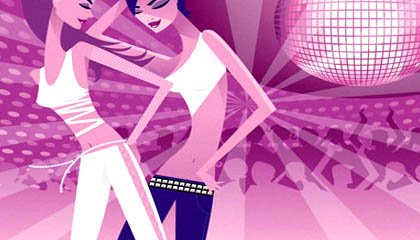
As the 1970's began, the term "rock & roll" had become almost nearly
meaningless. This decade began with the breakup of the Beatles and just earlier, the
death of Elvis Presley, Jimi Hendrix, Janis Joplin which robbed rock of major
influences. Pop music splintered into a multitude of styles: soft-rock, hard rock,
country rock, folk rock, punk rock, shock rock and includng jazz rock. As people were
dazed by a violent decade of war, assasinations, drugs, and silent corporate
takeover, television ignited in comedy programs making way for "Family Pop," or the
birth of the teen idols. Earlier, The Monkies, who devised to cash in on the early
Beatles' success by applying the most superficial aspects of the British Invasion
formula to capture a preteen audience, made way for the advent of Family Pop and the
teen-idol beginning with the Jackson Five and Michael Jackson, but the '70s successor
to the Monkees were The Partridge Family with the face and voice of teen-idol David
Cassidy. Shortly there after, the Osmonds, with younger brother Donny propelling into
teen-idol superstardom much like Michael was for the Jacksons. As the teen-idol
superstardom continued to produce a slew of others, in the background of that
spotlight, rock music was quietly still big business.
Among the top names in popular rock music at the time music were,
The Eagles, Aerosmith, Eric Clapton and Cream, Beach Boys, Neil Young,
Crosby-Stills-Nash & Young, Elton John, Alice Cooper, The Who, Lynyrd Skynyrd,
Maria Muldaur, Cheap Trick, Toto, Alice Cooper, Frank Zappa, Gordon Lightfoot,
Emerson Lake and Palmer, Bread, Golden Earring, Queen, Lynard Skynyrd, Toto, Grand
Funk Railroad, Peter Frampton, Billy Joel, Bob Seger, Boz Scaggs, J. Geils Band,
Kansas, Jim Croce, Black Sabbath, Rolling Stones, Blue Oyster Cult, Deep Purple,
Allman Brothers, Fleetwood Mac, Jefferson Starship, The Sweet, America, Jimmy
Buffet, The Cars, Foreigner, Rose Royce, Grateful Dead, Guess Who, ZZ Top, James
Taylor, Carly Simon, Carole King, Joan Biaz, Jackson Browne, The Kinks, Led
Zeppelin, Bad Company, Bruce Springsteen, Rolling Stones, Chicago, BeeGees, The
Temptations, KC & the Sunshine Band, Linda Rondstadt, Hamilton Joe Frank and
Reynolds, Sister Sledge, Blondie, Cher, Joe Cocker, CCR, Deep Purple, Doobie
Brothers, Supertramp, ELO, Patti LaBelle, Commodores, Kool and the Gang, Olivia
Newton John, Roy Orbison, REO Speedwagon, Sly and the Family Stone, Steely Dan,
Jackson 5, Rod Stewart, Marvin Gaye, Aretha Franklin, Wild Cherry, *Bay City
Rollers, Chic, The Carpenters, England Dan & John Ford Coley, Diana Ross, The
Knack, David Bowie, Sister Sledge, The Pointer Sisters, 10cc, The Village People,
Santana, Kiss, Paul Anka, Michael Jackson, Pink Floyd, Cat Stevens, The Carpenters,
Heart, Jethro Tull, Traffic, Gerry Rafferty, Paul Davis, Chuck Mangione, Yes, Neal
Sedaka, Boston, Bobby Sherman, Kansas, Charlie Daniels Band, Steve Miller Band,
Simon & Garfunkel, Seals and Croft, Paul McCartney and Wings, Eric Burdon &
War, Bread, Yvonne Elliman, Nick Gilder, Andy Gibb, Samantha Sang, Hall and Oates,
Stevie Wonder, Loggins and Messina, Leo Sayer, Captain & Tennille, Barry White,
ABBA, Rick Springfield, Boston, Styx, Bob Dylan, Derek & The Dominos, Thelma
Houston, Stevie Wonder Barry Manilow, Blondie, Pablo Cruise Natalie Cole, Stephen
Bishop, John Denver, Anne Murray, Bonnie Tyler, Randy Newman, Roberta Flack and
Donny Hathaway, Little River Band, Meatloaf, Three Dog Night, Cat Stevens, Ray
Stevens, Tony Orlando and Dawn, and Bob Marley gained a huge core of fans in the
U.S. performing Jamaican reggae music.
But the Most influential music of the decade was Disco
Disco is an up-tempo style of dance music that originated in the early 1970s,
mainly from funk and soul music, popular originally with gay and black audiences in
large U.S. cities, and derives its name from the French word discothèque
(meaning nightclub), coined from disc + bibliotèque (library) by La
Discothèque in Rue Huchette.
Deep funk begot proto-disco (1970-1975)
Before the word disco existed, the phrase discotheque records was used to denote
music played in New York private rent or after hours parties like the Infinity, The
Loft and Better Days. The records played there were a mixture of funk, soul and
European imports [LP-cuts or 45s]. We will call this genre of music "proto disco".
These "proto disco" records are the same kind of records that were played by Kool
Herc on the early hip hop scene.
Disco 2.0 (1976-1982)
The times change, the drugs change, new clubs like the Paradise Garage open their
doors, the disco twelve inch was invented. For the first time in musical history,
music was made with "discotheques" in mind. The disco years ended with its gay
audience decimated by a deadly disease called AIDS. My preferred disco labels of this
era are Salsoul, Prelude and West end. A perfect CD-introduction to the music of this
era is the superb three-volume compilation Give Your Body Up: Club Classics &
House Foundations, vol. 1, vol. 2 and vol. 3.
The twelve inch single
The twelve inch vinyl recording was a technical innovation. Because 45s were geared
for radio, they were all 'middle,' and you couldn't cut a lot of [bass] onto the
record, the twelve inch record allowed more bass and made records suitable for night
club play. The first promotional copies appeared in 1975 and the first commercial
release was the 1976 release 'Ten Percent' by Double Exposure, on the Salsoul
label.
The 12-inch single was a late and unexpected child of the recording industry. It was
therefore given a name to distinguish it from its older vinyl siblings. "12-inch"
refers to the diameter of the record — which it shares with the LP. "Single"
refers to the quantity of songs per side — as on the 45 rpm single. Whereas 45s
and LPs have been common fare since the late 1950s and 1960s, respectively, 12-inch
dance singles were issued first in mid-1975, and then only to a small clientele:
disk-jockeys, alternatively known as DJ's, who were perceived to constitute the only
group to become attracted to the new format. --Kai Fikentscher, "Supremely clubbed,
devastatingly dubbed", 1991
1976
Salsoul release the first commercially-available 12 inch. Walter Gibbons takes
double Exposure’s Ten Percent’ and works it into an 11 minute disco
extravaganza. Repetitive beats, disco music as we know it was born.
Walter Gibbons (1954 - 1994)
... he turned otherwise unremarkable dance records into monumental
sculptures of sound ...
Profile
 Gibbons was born in Brooklyn on 2 April 1954. He grew up
with his mother, Ann, his sister, Rosemary, and his two brothers, Robin and Edward.
Nothing is known of his father — friends say he never spoke of him — and
little more is known of his young adult life save that he subsequently moved to
Queens, dated men and
collected black
music.
Gibbons was born in Brooklyn on 2 April 1954. He grew up
with his mother, Ann, his sister, Rosemary, and his two brothers, Robin and Edward.
Nothing is known of his father — friends say he never spoke of him — and
little more is known of his young adult life save that he subsequently moved to
Queens, dated men and
collected black
music.
Gibbons was easy to miss. An innocuous white boy with an unconvincing
moustache and carefully combed brown hair that was parted right to left, he stood at
approximately five foot five and, thanks to his pencil thin build, looked like he
would need help carrying his records to work. Shy and softly spoken, he kept himself
to himself. He preferred cigarettes to chatter.
But when Gibbons stood
behind the turntables at Galaxy 21, an after hours venue on
Twenty-third Street owned by black entrepreneur George Freeman, he was hurricane
articulate. It was almost as if he kept his daytime thoughts to himself because he
knew he could articulate them with so much more force through the Galaxy sound system
at night. Why talk when you can DJ? --Tim Lawrence via the liner notes to Mixed
with Love, http://www.timlawrence.info/linernotes/2005/walter_g.php
[Jan 2005]
First Commercial 12" [...]
It was Gibbons transformation of Double Exposure's
Ten Percent from a three
minute album track into an eleven minute dancefloor stormer that radically changed
the disco undergound in terms of record production, remixing and development of the
12" record. At the time when orchestration was commonly used on dance records,
Gibbons' technique was to concentrate on percussion and the song. He was an explorer
and innovator of DJ techniques and skills which we now take for granted and he was
also considered to be one of the most impeccable live mixers of his time. Walter
Gibbons' Djing began in the early 70s in NYC at the Galaxy 21, Fantasia, and
Buttermilk Bottom, Second Story in Philadelphia and the Monastery in Seattle. Years
before his death Gibbons became a Born Again Christian and wouldn't mix songs with
sexual content. However, he resurfaced in 1984 with the unforgettable
electro classic
Set It Off, and did
two more mixes for
Arthur Russell in 1986.
Ten Percent (Nov 1976) - Double Exposure
Walter Gibbons didn't just electrify fellow DJs and suburban dancers. He
also electrified Ken Cayre, head of a newly formed label called Salsoul, which had created a minor
tremor in Nightworld with the release of the Salsoul Orchestra's debut album. The
Salsoul boss proceeded to sign Double Exposure and realised soon after that Gibbons
could help him market the group's first single. "Walter was very aggressive when it
came to searching out new records," says Cayre. "He became friendly with Denise
Chatman, our promotions girl, and we went to hear him play. I was very impressed with
his skills."
Cayre was particularly taken with the way the DJ worked "Ten Percent", which had
been released as a non-commercial promotional twelve-inch test pressing that
consisted of the standard single plus a longer version. "We knew the DJs wanted
longer records so we told the producers to get the musicians to jam for a couple of
minutes after they had recorded the regular song," says Cayre. "I had to release the
promotional twelve-inch single because the seven-inch wasn't doing well." Having laid
his hands on two copies of the test pressing, Gibbons worked up a whirlwind. "He did
this fantastic edit
and the reaction in the club was phenomenal. I said, 'Can you do that in the studio?'
He said he could."
Salsoul gave Gibbons and engineer Bob Blank three hours to complete
the remix at Blank Tapes Studios. That meant the duo had one hour to put up the mix
and channel the sound, one hour to break down the recording and one hour to cut up
tape with a razor blade. "Walter was prepared but he couldn't prepare everything,"
says Blank. "He had to be ready to do 'brain work' on the spur of the moment. The
session was very intuitive. Walter was a real genius."
By the end of the session the diminutive DJ had transformed a dense four-minute
song into a nine-minute-forty-five-second roller coaster. He was paid $185 for his
efforts — $85 to cover a night's work at Galaxy, plus $100 for the blend
— and he started to spin an acetate of the remix, which was effectively a
readymade version of the lightning-quick collages he had already been concocting at
Galaxy, in late February/early March 1976.
"'Ten Percent' was one of the best mixes anyone had ever heard," remembers Smith.
"Walter turned a nice song into a peak song." The remix became an instant classic. "I
heard it on an acetate in the Gallery," says Mixmaster editor and downtown
connoisseur Michael Gomes. "It sounded so new, going backwards and forwards. It built
and built like it would never stop. The dance floor just exploded."
Salsoul released the twelve-inch — the first commercially released
twelve-inch — in May, much to the chagrin of the Philadelphia-based songwriter
Allan Felder. "The mixer cut up the lyrics and changed the music," Felder told me
shortly before he passed away. "It was as if the writers and producers were
nothing."
Gibbons didn't set out to offend. Blank notes the DJ-turned-remixer was "very,
very, very concerned" the artists, producers and writers would feel he had done the
record justice. But DJs were widely regarded as musical parasites and the idea that
they should be given carte blanche to remix an original work of art was doggedly
opposed by music-makers. The development was seen as being nothing short of
scandalous and Gibbons lay at the centre of the action.
Cayre stayed calm and kept his focus. "Walter was the first DJ to show the record
companies that they should be open to different versions of a song," he says. "They
were in the club night after night so they knew what worked and what didn't work.
Walter was pivotal. He convinced producers and other record companies to give the DJs
an opportunity to remix records for the clubs. And he showed us that these records
could be commercially successful. People didn't believe that was possible before 'Ten
Percent'. Walter was a pioneer." --Tim Lawrence via the liner notes to Mixed with
Love, http://www.timlawrence.info/linernotes/2005/walter_g.php
[Jan 2005]
Biography
Apr 02 1954 to Sep 23 1994
Hit and Run (1977) - Loleatta Holloway
[t]he DJ's remix of Loleatta Holloway's "Hit And Run", which was recorded at Sigma Sound in April
1976 and released on Holloway's album, Loleatta, in December. Gibbons asked
Cayre if he could remix the song and the Salsoul chief,
taking a deep breath, decided to entrust his little prince with the multitrack
[see also: http://en.wikipedia.org/wiki/Multitrack_Recording].
"'Hit And Run' was the first time that a studio let a DJ completely rework the song,"
says Cayre, "and Walter, the genius that he was, turned it into a twelve-minute,
unconventional smash."
Having been restricted to carrying out a cut-and-paste reedit of the
half-inch master copies for "Ten Percent", Gibbons was now able to select between
each individual track, and he dissected and reconstructed the six-minute album
version in the most sweeping manner imaginable: a swathe of strings and almost all
the horns were sliced out in order to emphasise Baker, Harris and Young's exquisite
rhythm track, and, in a high-risk move, the remixer shifted the focus of the song by
cutting the first two minutes and all of the verses of Holloway's vocal.
Salsoul's bigwigs were aghast. "When Walter played me his mix I initially wanted
to choke him," says Cayre. "Loleatta wasn't there anymore. Walter just told me that I
had to get used to it." Always up for a party, the mogul went to listen to Gibbons
play the twelve-inch in its intended setting and "after hearing it a couple of times"
he knew that Gibbons "had done the right thing." --Tim Lawrence, http://www.timlawrence.info/linernotes/2005/walter_g.php
[Jan 2005]
Trivia: Carl
Craig's Throw (Open) (1994) is based on a small sample from "Hit and Run"
[about 7 minutes into the original]
Tape Editing, from Reel to Reel [...]
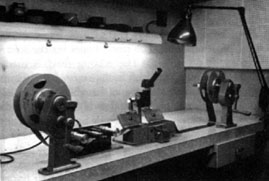
What I say is that the first 'cut-ups' were by Walter Gibbons - the first
great 'mixing' DJ. These date from 1974/5 and use funky records like The Fatback Band
[building] up to latin percussion jams, cut up on reel-to-reel tape … and used
to provide a continuous mix (sometimes 20 minutes plus) in the clubs of New York. A
good example of this would be the 'looped up' 'break' (remember, nobody knew these
terms back then!) from the Cooley High soundtrack album [‘Two
Pigs and a Hog’]. First he used two copies [of the record] to capture the
break, then did it on tape to be cut onto an acetate, thus saving the hassle of doing
it live all the time. -- Colin Gate via http://home.wanadoo.nl/discopatrick/history.htm
[Jan 2005]
Gibbons, Luongo, Herc
Performing in parallel yet unconnected universes, DJ Kool Herc in the Bronx and John
Luongo in Boston started to play back-to-back breaks around the same time as Gibbons,
but neither of them could match the Galaxy mixmaster's razor precision. --Tim
Lawrence, http://www.timlawrence.info/linernotes/2005/walter_g.php
[Jan 2005]
1983 Profile by Steven Harvey
Outside a disco
Walter Gibbons is the least
known of the mixers profiled here. This in no way diminishes his importance. Walter
not only mixed the first 12 Inch single '10 Percent' by Double Exposure - he
completely transformed it from a three minute album track into 11 minutes of break
after break. It was a revolution - a record designed specifically for the underground
club scene in New York.
"You really have to think that every time you change the record, the title or
something about the record is going into people's heads. For me, I have to let God
play the records, I'm just an instrument."
His trademark was a concentration on the percussion, the song and the singer.
Where many of the period releases by Salsoul were heavily orchestrated, Walter
stripped down his tracks to essence. Two Salsoul albums, 'Disco Boogie Vols 1 &
2' (the first disco party album) and 'Disco Madness' feature his mixes. The latter
has him singing 'It's Good For The Soul', a perfect slice of what he is playing now
and the reason he no longer works in the dance music industry. When he became a
born-again Christian he stopped playing songs that were not uplifting. That pretty
much eliminates the majority of dance music dealing with sexuality.
Walter was considered to be one of the most impeccable live mixers of his time. He
could play the impossibly slow intros to 'Love Is The Message or 'Love Hangover' and
still keep the dancing going by his edits of the segues. He anticipated breakstyle
mixing with his percussion blends of tunes like 'Two Pigs and A Hog' (from Cooley
High soundtrack) a one minute break that he would cut up with two copies.
Many people think that in the vastly competitive dance music business, once you
drop out you are through. If Walter's faith keeps on, some record company might
realise that he would be the perfect mixer for a new Philly style release or a gospel
dance track. Perhaps 'Faith' - the unreleased track he mixed and produced with Steve
D'Aquisto - would be a good place to start
From the beginning of playing records, the issue was getting a message or
narrative across through the songs. Now it's 'in the mix'
''I think I did that. I used to keep a book of what were my top records every
week, Looking back it scares me - at that time I wasn't very Christ minded. Music is
too easy to make - there are Spirits in records. You really have to think that every
time you change the record, the title or something about the record is going into
people's heads. For me, I have to let God play the records, I'm just an
instrument.''
That's appropriate to DJing as a modern art form where the DJ is basically the
instrument, the medium for other people's music.
' Unlike most DJs, I do requests I like to know what they're thinking too, The
thing about requests is if you can change what they're thinking into something
positive. This girl used to like 'Nasty Girls' so I'd play it. My thought behind that
would be a record like 'Try God' by the NY Community Choir which is the total
opposite."
Sort of advocate style spinning. "The last time I saw Tee Scott I bought a record for him.
it was a mix of 'Law Of The Land' by Undisputed Truth with a little bit of 'Ten
Percent' and the Ten Commandments spoken. He played it and the crowd roared like I've
never heard in my life. Especially after the part where he's saying 'thou shalt not
commit adultery, thou shall not steal. thou shall not kill' - there was such a roar.
it was like WOW, compared to what they hear normally. It was very interesting." --Steven Harvey,
1983, Collusion Magazine
Profile
It was a New
York disco-era deejay, Walter Gibbons, who pioneered many of the techniques of
disco mixing that would become the lifeblood of house deejays-turned-producers in the
`80's. After years out of the spotlight, Gibbons resurfaced in 1984 with a mix of a
12-inch single called 'Set It Off' that would define the New York dance underground.
It created a sensation at the Garage, where it was
championed by Levan, and spawned countless
remakes by the likes of C. Sharp and Masquerade and at least one answer single,
Number 1's 'Set It Off (Party Rock)'. Perhaps the definitive version of 'Set It Off'
was Strafe's, with its mesmerizing vocal hook woven into a spare but hauntingly
atmospheric rhythm bed.-- Greg Kot
Francois Kevorkian
February 1976: Walter Gibbons was DJ at the Galaxy 21 when Francois K. got hired to
play live drums over Walter's records.
Faze Action
Faze Action on
Walter Gibbons: "Like Brian Jones and Keith Richards poring over their blues
records, Faze Action are purist scholars of the form -- for them the Salsoul
Orchestra is Howlin' Wolf and Walter Gibbons is Muddy Waters." [...]
Selected Discography
-
12D-2008 Double Exposure 'Ten Percent' (1976)
first commercially available
12"
-
12D-2011 Salsoul Orchestra 'Nice 'n' Nasty' (1976)
- 12D-2030 Anthony White 'I Can't Turn You Loose'/'Block Party' (1977)
- SG 2067 Cellophane 'Super Queen' (1978)
- SG 2071 Luv You Madly Orchestra 'Rocket rock / Moon maiden' (1978)
- SG 311 Robin Hooker Band 'Stand By Your Man' (1979)
- WES 12113 Bettye Lavette 'Doin'the Best I Can (Short)' (1978)
- WES 12113x Bettye Lavette 'Doin'the Best I Can (Long)' (1978) go for the
long version
- Colleen Heather: "Heartbreaker" LP (West End WE 108, 1979). Co-credited.
- GG-402 Loleatta Holloway 'Catch Me On the Rebound' (1978)
- GG-40O3 Love Committee 'Cheaters Never Win' (1977)
- GG-4006 Loleatta Holloway 'Hit And Run' (1977)
- GG-4011 Love Committee 'Just As Long As I Got You' (1978)
- True Example: "Love is finally comin' my way" b/w "As long as you love me"
(Gold Mind 12G 4005, 1977). Two releases exist of this record. One credit Walter
Gibbons while the other not.
- Various Artists: Saturday night disco party (Salsoul SA 8505, 1978).
Co-credited with Tom Moulton & Jim Burgess
- Salsoul Orchestra: Greatest disco hits (Salsoul SA 8508, 1978)
- Various Artists: Disco madness (Salsoul SA 8518, 1979)
- Various Artists: Salsoul's greatest 12" hits Vol. 1 (Salsoul CA 1002, 1982),
Co-credited with Tom Moulton
-
SLX-23 Indian Ocean 'Tree House' / 'School Bell' 1986
- Produced by Arthur Russell and Peter
Zummo
- Mixed with Love by Walter Gibbons
-
Logarythm 12" LR-1002-1 1002 Arthur Russell 'Let's Go
Swimming' (1986)
-
gulf stream dub / puppy surf dub / coastal dub /
Coastal
dub
Mixed with Love by Walter Gibbons
-
Strafe 'Set It Off' (1984)
- Steve Standard and George Logios (Bombers?)
- Sandy Mercer: "Play with me" b/w "You are my love" (H&L 2005, 1978),
co-credited with Steve D'Acquisto
- Gladys Knight & the Pips : It's a better than good time (Buddah DSC 130,
1979). Canadian issue. I never saw an american print of this.
History of House
Most Chicago DJ's admit a debt to the underground 1970's underground club scene in
New York and particulary the original disco-mixer Walter Gibbons, a white DJ who
popularised the basic techniques of disco-mixing, then graduated to Salsoul Records
where he turned otherwise unremarkable dance records into monumental sculptures of
sound.It was Gibbons who paved the way for the disc-jockey's historical shift from
the twin-decks to the production studio. But ironically, at the height of his cult
popularity, he drifted away from the decadent heat of disco to become a "Born Again
Christian", having created a space which was ultimately filled by subsequent DJ
Producers like Jellybean Benitez, Shep Pettibone, Larry Levan, Arthur Baker, Francois
Kervorkian, The Latin Rascals, and Farley "Jackmaster" Funk. Most people believed
that Walter Gibbons was a fading legend in the early history of disco, then in 1984
he resurfaced, and had a new and immediate impact on the development of Chicago House
Sound. Gibbons released an independent 12" record called "Set It Off" which started
to create a stir at Paradise Garage, the black gay club in New York, where Larry Levan
presided over the wheels of steel. Within weeks a "Set It Off" craze spread through
the club scene, including new versions by C. Sharp, Masquerade, and answer versions
like Import Number 1's "Set It Off(PartyRock)". The original
record had been "mixed with love by Walter Gibbons" and was released on the Jus Born
label, a tongue in cheek reference to Walter's christianity. Gibbons had set the tone
again, the "Set It Off" sound was primitive house, haunting, repetitive beats ideal
for mixing and extending. It immediately became an underground club anthem, finding a
natural home in Chicago, where a whole generation of DJ's including Farley and
Frankie Knuckles, rocked the clubs and regularly played on local radion stations. --
Stuart
Cosgrove on The History of House Sound of Chicago BCM Records, Germany
Set it Off
- The Perfect
Beats, Vol. 2 [Amazon US]

1. Let The Music Play - Shannon 2. I.O.U. - Freeze 3. Dancing On The Fire -
Jellybean 4. Crash Goes Love - Loleatta Hollaway 5. My Love Is Alive - Chaka Khan
6. The Dominatrix Sleeps Tonight - Dominatrix 7. For The Same Man - B Beat Girls 8.
Infatuation - Upfront 9. Hip Hop Be-bop - Man Parrish 10. Set It Off - Strafe
11. Moody - Esg 12. Cavern - Liquid Liquid 13. Together Forever - Exodus 14.
Confusion - New Order 15. Slack - Slack
Following the history lesson of volume 1, The Perfect Beats, Volume 2 reaches a
little wider in its selection of electro-boogie, hip-hop, and freestyle oldies.
This seems to be the set's unofficial "happy" disc--some of the fastest cuts are on
this volume, as well as the lightest and most playful. (Even the monochromatic
series package design adds to the effect--this volume's a sunny orange.) "Let the
Music Play" by Shannon (one of the highest-charting records in the collection)
appears in a livelier-than-life remix, and just try to resist the bubbly
synth-vibraphone on Dominatrix's "The Dominatrix Sleeps Tonight." Lots of these
cuts will be familiar as the source of samples that fueled bigger hits, especially
Liquid Liquid's "Cavern," which formed the basis for Grandmaster Flash and Melle
Mel's huge rap record "White Lines." --John Sanchez
Mixed with Love (2004) - Walter Gibbons
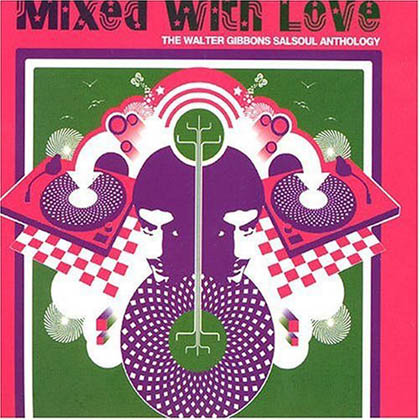
Beluga
(2004) - Jean Van Cleemput [Amazon.com] [FR] [DE] [UK]
1. Ten Percent (Original 12" Mix) 2. Block Party (Original 12" Mix ) 3. Catch Me
On The Rebound (Original 12" Mix) 4. Just As Long As I Got You (Original 12" Mix) 5.
It’S Good For The Soul (Original Lp Remix) 6. Let No Man Put Asunder (Original
Lp Remix) 7. Love Is Finally Coming My Way (Original 12” Mix) 8. We’Re
Getting Stronger (Original 12" Mix) 9. Ice Cold Love (Original Lp Remix) 10. Cheaters
Never Win (Original 12" Mix) 11. Law & Order (Original 12" Mix) 12. Catch Me On
The Rebound (Original Lp Remix) 13. As Long As You Love Me (Original 12" Mix) 14. I
Can’T Turn You Loose (Original 12" Mix) 15. My Love Is Free (Original Album
Remix) 16. Hit & Run (Original 12" Mix) 17. I Wish That I Could Make Love
(Original Lp Remix) 18. Nice N’ Naasty (Original 12" Mix) 19. Where Will It End
(Original 12" Mix) 20. Salsoul 3001 (Original 12" Mix) 21. Moon Maiden (Original 12"
Mix) 22. (Dance With Me) Let’S Believe (Original 12" Mix) 23. Catch Me On The
Rebound Inst (Original 12" Mix) 24. Ten Percent (Original Lp Remix) 25. Rocket Rock
(Original 12" Mix) 26. Magic Bird Of Fire (Original Album Remix) 27. Super Queen
(Original 12" Mix) 28. Stand By Your Man (Original 12" Mix) 29. Your Cheatin’
Heart (Original 12" Mix)
Yet Walter Gibbons, against all
odds, still became a DJ's DJ. "Everyone was going to hear Walter," says Smith, who
would go down to Galaxy once he had wrapped up for
the night at Barefoot Boy. "Most DJs finished at four so we could hear
Walter from five until ten." After that, Gibbons and Smith would go for breakfast
and, weather permitting, a trip to the beach, where they would talk about music. "DJs
couldn't go and listen to too many people because we had played all night and didn't
want to hear the same thing all over again. But we knew Walter would turn us on.
Everyone showed up." --Tim Lawrence via http://www.timlawrence.info/writing-pages/wg_mixed-w-love.html
[Jan 2005]
[...]
Having been restricted to carrying out a cut-and-paste reedit of the half-inch master copies
for "Ten Percent", Gibbons was now able to select between each individual track [see
also: http://en.wikipedia.org/wiki/Multitrack_Recording],
and he dissected and reconstructed the six-minute album version in the most sweeping
manner imaginable: a swathe of strings and almost all the horns were sliced out in
order to emphasise Baker, Harris and Young's exquisite rhythm track, and, in a
high-risk move, the remixer shifted the focus of the song by cutting the first two
minutes and all of the verses of Holloway's vocal. --Tim Lawrence via http://www.timlawrence.info/writing-pages/wg_mixed-w-love.html
[Jan 2005]
Tom Moulton
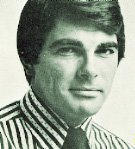 Tom Moulton was a fashion model on hiatus from the music
business when he visited Fire Island's Botel during a photo shoot. "I got a charge
out of it, all these white people dancing to black music."
Painstakingly, he spent 80 hours making a 90-minute dance tape using sound-on-sound
and vari-speed to create a nonstop build. The Botel's owner rejected the tape, but
the competing Sandpiper offered to listen, and Moulton left the reel. At 2:30 on a
Saturday morning, Moulton was awakened by a call from the Sandpiper that was
unintelligible except for the screaming of dancers. To a tape!
Tom Moulton was a fashion model on hiatus from the music
business when he visited Fire Island's Botel during a photo shoot. "I got a charge
out of it, all these white people dancing to black music."
Painstakingly, he spent 80 hours making a 90-minute dance tape using sound-on-sound
and vari-speed to create a nonstop build. The Botel's owner rejected the tape, but
the competing Sandpiper offered to listen, and Moulton left the reel. At 2:30 on a
Saturday morning, Moulton was awakened by a call from the Sandpiper that was
unintelligible except for the screaming of dancers. To a tape!
Biography
Tom Moulton (1940) is an American record producer and originator of the remix and the
12-inch vinyl format.
He was one of the earliest disco DJs in New York, USA. --http://en.wikipedia.org/wiki/Tom_Moulton
[Aug 2005]
The First 12" was a 10" :-)
"OK, Well - You have to remember something - so many great ideas are accidents...
I mean - I thought it [the 12" single] was a great idea
AFTER the fact.
You see, this is going back now to the early 70's, when I first started I took my
records to Media Sound to master.
Tom continues; "So, the thing is - one day I went in there to José -
José Rodriguez - and I had "I'll be holding on" by Al Downing
and I said; "José, I could really need some acetates." And he said; "Just Tom,
I don't have any more 7" blanks. All I have is like the 10"." And I said; "Well, if
that's the only thing - we're gonna do it, what difference does it make?". So he cut
one, I said; "It looks so ridiculous, this little tiny band on this huge thing. What
happens if we just like... can we just like, you know, make it bigger?". He goes;
"You mean, like spread the grooves?" and I said; "Yeah!". He goes; "Then I've
got to rise the level." I said; "Well, Go ahead - rise the level." And so he cut it
like at +6. Oh, when I heard it I almost died. I said; "Oh my God, It's so much
louder and listen to it. Oh! I like that - why don't we cut a few more?". So it was
by accident, that's how it was created.
But for the next song we cut, we went for the 12" format instead of the 10" and
the song was "So much for love" by Moment of Truth. That was the birth of the
12" single.
--
Claes Widlund interviews Tom Moulton (1999) http://disco-disco.com/tributes/tom.html
[Dec 2004]
On Vince Montana [...]
Tom Moulton in an interview with Claes Widlund :
And, if you listen to Vince you would think that Gamble & Huff kept stealing
from him. Look at this, it has been so many times where I have tried to help out
Vince and I just don't understand him.
But at Salsoul... He got mad at me when I produced the album the... Oh, what the
hell was it called now - "Street sense". And I was only asked to do it because Vince
was being so difficult with Salsoul. He was giving Salsoul such a hard time. And then
I remixed the Christmas album, he knows that."
"You know, Vince can not say someone else does anything good. I wish I could
understand him, I just don't. I just try and try and try, but I just don't understand
him, so... 'Cause he didn't tell you that his album "Close Encounters of the Third
Kind" - this is after he starts mixing his own records "A Vince Montana Mix". I mean,
that's about as close to copying me as anybody can. And then he begs me to mix his
album because Atlantic rejected it. He called me the day before Christmas and begged
me. I said "Vince, I can't do this." He said "You're a shit" and then "Oh Tom, I'm
sorry and bla bla bla bla bla" I mean, I couldn't believe it - no one else could
either.
And I said "Vince, I'll do it on two conditions...". He said "What's that?". I said
"You are not there and if you say one word to me other then Hello or Goodbye - I'm
leaving!". And he did, and no one would believe it. Well I ended up mixing it, then
they accepted it." --
Claes Widlund interviews Tom Moulton (1999) http://disco-disco.com/tributes/tom.html
[Dec 2004]
Profile by Brian Chin
Tom Moulton's concepts singlehandedly created a new industry of
remixing--producing records with greater dance impact. He leapfrogged Philadelphia
sonics by rebalancing the frequency range, extending the high frequencies much
further than Motown ever did. "Because 45s were geared for radio, they were
all 'middle,' and you couldn't cut a lot of [bass] onto the record. A lot of records
didn't have the fidelity and sounded terrible. But you were playing them for the
songs, not the fidelity."
That regard for the integrity of a song also guided Moulton in the studio. He not
only sharpened sound for high-volume nightclub play, but he also restructured
records, setting up hooks and repeating the best parts, greatly amplifying the
original song scheme's tension and release. He'd tweak levels obsessively all through
the record--effectively rephrasing a track or vocal by hitting the volume
control--when he felt it would increase intensity. "I was so wired into the song.
They thought I was crazy. But you go for the blood and guts, the thing that really
counts in a song." Moulton's hook might be a mistake by the players, and he points
out that the insane sonic power of "Disco Inferno" happened when he was compensating
for a console that was set up wrong. Repeatedly--with the simple woodblock in "More,
More, More (Part 1)," in the strong but never overdone pop pump of "Instant Replay"--
Moulton made good records stronger. His blueprint has been used thousands of times
over.
Moulton worked in promotion for Scepter Records, and mixed DCA Productions' "Dream
World" by Don Downing for the label. In 1974, when DCA called him to work on Gloria
Gaynor's first album, he made history. Never Can Say Goodbye featured a
side-long medley of three long songs segued together. Meco Monardo says it was "a
revelation" when Moulton extended three-minute songs to more than six by lengthening
the instrumental. But Moulton knew by instinct that this would intensify and modulate
the impact of a song or a series of songs: "You start here [he points down], and go
allll the way up." Incredibly, Moulton's credit does not appear on the album
because of a potential conflict: he'd by then launched the first music trade-paper
column on the scene, "Disco Mix," in Billboard.
Like everything else in disco, formula set into remixing, but it wasn't Moulton's
fault. He often critiqued remixers for making music into a DJ tool, instead of mixing
to maximize the original intent of a song. He used drum breaks, for example, as
transitions within a song, to set up an emotional rush with the return of the rest of
the music, or when key changes made a break necessary to create dramatic
structure--not merely because drum breaks made it easier for a DJ to mix in or out of
a record. "People have said, 'You make disco records,' and I said: 'Wrong. I make
records you can dance to.' I wouldn't know how to make a record just for discos."
source: http://www.rhino.com/features/liners/75595lin7.html
--Brian Chin
Disco Records
"People have said, 'You make disco records,' and I said: 'Wrong. I
make records you can dance to.' I wouldn't know how to make a record just for
discos."
Soul Jazz presents: A Tom Moulton Mix (2006) - Various Artists
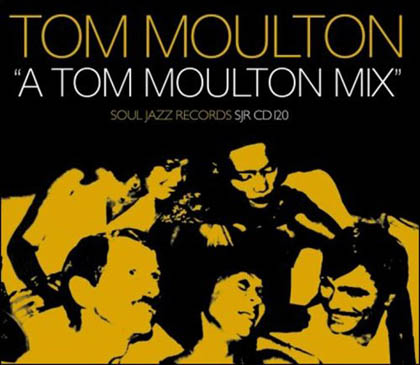
Soul Jazz
presents: A Tom Moulton Mix (2006) - Various Artists [Amazon.com] [FR] [DE] [UK]
Track Listings
1. I'll Be Holding On 2. Keep On Truckin' 3. La Vie En Rose 4. Moonlight Loving 5.
Peace Pipe 6. Dream World 7. You've Got The Power 8. Make Me Believe In You 9. Free
Man 10. Needing You 11. Feel The Need In Me 12. Moonboots 13. Lip Service 14. Love Is
The Message 15. More More More 16. Won't You Try
Product Description
''A Tom Moulton Mix'' is released today on Soul Jazz Records. This is the first
album to bring together some of the classic and rare tracks that have been blessed
with the phrase "A Tom Moulton Mix" on the record label. Tom Moulton is one of the
most important people in the history of dance music. From inventing the first ever
12" single to remixer to the stars, the trademark "A Tom Moulton Mix" is a mark of
quality given to only the finest records -From Grace Jones' seminal "La Vie En Rose"
to the million-selling MFSB disco anthem "Love Is The Message", to over 4000 remixes
in an incredible career that has now lasted over 30 years.
New Tom Moulton compilation on Soul Jazz.
Source: www.jahsonic.com
PageTOP ^
Disclaimer


 An often underrated 60s British Beat group is
The Hollies. OK, they didn't write their own songs until after the mid-60s,
but they were great singers and songs by writers such as Graham Goldman
sounded terrific when covered by Graham Nash, Allan Clarke et co. Recordings such as
"Bus Stop", "Yes I Will" and "He Ain't Heavy He's My Brother" all sound almost as
great as anything done by the Fab Four, and with "King Midas In Reverse" and the
entire "Butterfly" album they also proved they could be adventurous.
An often underrated 60s British Beat group is
The Hollies. OK, they didn't write their own songs until after the mid-60s,
but they were great singers and songs by writers such as Graham Goldman
sounded terrific when covered by Graham Nash, Allan Clarke et co. Recordings such as
"Bus Stop", "Yes I Will" and "He Ain't Heavy He's My Brother" all sound almost as
great as anything done by the Fab Four, and with "King Midas In Reverse" and the
entire "Butterfly" album they also proved they could be adventurous. Best of all, though, was the often
shamefully overlooked The Zombies (picture right). Their "Oddysey and Oracle"
album from 1968 is IMO one of the best pop albums ever made, but sadly the band had
already decided to break up by then as a result of poor sales and lack of public
acceptance. However a lot of musicians admired them a lot, and now it seems that
people are finally rediscovering their gems (not only "Oddysey and Oracle", but also
such wonderful early singles as "She's Not There" and "Tell Her No"..
Best of all, though, was the often
shamefully overlooked The Zombies (picture right). Their "Oddysey and Oracle"
album from 1968 is IMO one of the best pop albums ever made, but sadly the band had
already decided to break up by then as a result of poor sales and lack of public
acceptance. However a lot of musicians admired them a lot, and now it seems that
people are finally rediscovering their gems (not only "Oddysey and Oracle", but also
such wonderful early singles as "She's Not There" and "Tell Her No"..

 The psychedelic period was a funny time
when a lot of musical experiments were done. Again Beatles were forerunners, as most
of their 1967 ranks among the finest psychedelic music ever. "Sgt. Pepper's Lonely
Heart's Club Band" still wins surveys about the greatest albums ever.
The psychedelic period was a funny time
when a lot of musical experiments were done. Again Beatles were forerunners, as most
of their 1967 ranks among the finest psychedelic music ever. "Sgt. Pepper's Lonely
Heart's Club Band" still wins surveys about the greatest albums ever. Some years later UK created its own answer
to Bubblegum. Glam Rock was harder edged and more rock'n'roll than Bubblegum
music, but the melodies were still nursery-rhyme-like. The name Glam Rock came from
how the artists appeared visually (with glam and glitter in their faces), but still
it also had musical components. A lot of Glam Rock is hitlist teen throwaway stuff,
but some of it actually was great pop. Slade, for instance, knew how to come
up with a great pop tune.
Some years later UK created its own answer
to Bubblegum. Glam Rock was harder edged and more rock'n'roll than Bubblegum
music, but the melodies were still nursery-rhyme-like. The name Glam Rock came from
how the artists appeared visually (with glam and glitter in their faces), but still
it also had musical components. A lot of Glam Rock is hitlist teen throwaway stuff,
but some of it actually was great pop. Slade, for instance, knew how to come
up with a great pop tune.
 Electric Light Orchestra (picture
left) originally were based on UK 60s pop group The Move. Led by Jeff Lynne
and Roy Wood they intended to keep up where Beatles stopped around 1967, with string
based rock music inspired by "Strawberry Fields Forever" and "I Am The Walrus". Roy
Wood soon left to form throwaway glam band Wizzard and Jeff Lynne was left to
build up ELO (as they were usually) called on his own. He recruited several string
players plus keyboardist Richard Tandy (Keyboards were to become an important part of
their sound) and started writing wonderful melodic pop tunes with great backing
vocals. During the late 70s they were superstars, thanks to such wonderful albums as
"A New World Record", "Out Of The black" and "Discovery".
Electric Light Orchestra (picture
left) originally were based on UK 60s pop group The Move. Led by Jeff Lynne
and Roy Wood they intended to keep up where Beatles stopped around 1967, with string
based rock music inspired by "Strawberry Fields Forever" and "I Am The Walrus". Roy
Wood soon left to form throwaway glam band Wizzard and Jeff Lynne was left to
build up ELO (as they were usually) called on his own. He recruited several string
players plus keyboardist Richard Tandy (Keyboards were to become an important part of
their sound) and started writing wonderful melodic pop tunes with great backing
vocals. During the late 70s they were superstars, thanks to such wonderful albums as
"A New World Record", "Out Of The black" and "Discovery". The third of the great early Power Pop
groups were Big Star (picture right). Led by pop legend Alex Chilton
they didn't sell that many records at once, but has since become legends and
important inspiration sources for almost any Power Pop band that was to follow.
"September Gurls" was their most famous song and has become a pop classic.
The third of the great early Power Pop
groups were Big Star (picture right). Led by pop legend Alex Chilton
they didn't sell that many records at once, but has since become legends and
important inspiration sources for almost any Power Pop band that was to follow.
"September Gurls" was their most famous song and has become a pop classic. Anyway the New Wave group that more than
anyone else were the favourites of pop pundits were Squeeze (picture left).
Obviously inspired by the Fab Four they made some truly great pop classics. Titles
like "Cool For Cats", "Up The Junction", "Tempted" and "Pulling Mussels From The
Shell" were all among the greatest pop stuff you could possibly find in the late
70s/early 80s.
Anyway the New Wave group that more than
anyone else were the favourites of pop pundits were Squeeze (picture left).
Obviously inspired by the Fab Four they made some truly great pop classics. Titles
like "Cool For Cats", "Up The Junction", "Tempted" and "Pulling Mussels From The
Shell" were all among the greatest pop stuff you could possibly find in the late
70s/early 80s. If you don't like synths you may as well skip
this whole chapter, because the UK early 80s New Romantics craze
definitely was about synths - synths, music video and image. But New Romantics
also was about great melodic pop songs, and groups such as Spandau Ballet,
Simple Minds, ABC, Culture Club, Japan, Thompson
Twins(picture right) and even teenyboppers Duran Duran made some songs
worth checking out.
If you don't like synths you may as well skip
this whole chapter, because the UK early 80s New Romantics craze
definitely was about synths - synths, music video and image. But New Romantics
also was about great melodic pop songs, and groups such as Spandau Ballet,
Simple Minds, ABC, Culture Club, Japan, Thompson
Twins(picture right) and even teenyboppers Duran Duran made some songs
worth checking out. One of the very first
underground pop labels were the Glasgow based Postcard label. One of their
bands were Aztec Camera, who were in reality Roddy Frame (Picture
left). He debuted with the album "High Land Hard Rain", a wonderful album that was
IMO the best debut album that has ever been released. After that he never quite
managed to follow it, although "Dreamland" from 1993 was a great album. The Postcard
label also had some other great pop artists, such as Orange Juice (led by now
succesful solo artist Edwyn Collins) and Paul Haig
One of the very first
underground pop labels were the Glasgow based Postcard label. One of their
bands were Aztec Camera, who were in reality Roddy Frame (Picture
left). He debuted with the album "High Land Hard Rain", a wonderful album that was
IMO the best debut album that has ever been released. After that he never quite
managed to follow it, although "Dreamland" from 1993 was a great album. The Postcard
label also had some other great pop artists, such as Orange Juice (led by now
succesful solo artist Edwyn Collins) and Paul Haig Even more important than what happened on
Postcard was XTC (picture right). This innovative and eccentric, still highly
poppy and melodic band started out as some sort of New Wave/Power Pop outfit, then
changed into a more "sophisticated" pop style. They were inspired by late 60s
psychedelic pop. On their later albums they have dropped their original low fi
profile to come up with possibly an even better sound. "Skylarking" from 1986 is IMO
one of the best albums ever made.
Even more important than what happened on
Postcard was XTC (picture right). This innovative and eccentric, still highly
poppy and melodic band started out as some sort of New Wave/Power Pop outfit, then
changed into a more "sophisticated" pop style. They were inspired by late 60s
psychedelic pop. On their later albums they have dropped their original low fi
profile to come up with possibly an even better sound. "Skylarking" from 1986 is IMO
one of the best albums ever made. Down under, in Te Awamutu, New Zealand,
Split Enz (picture left) was started in the early 70s. After making some truly
quirky prog rock inspired records during the 70s they turned into a more Power
Pop/New Romantics inspired sound. The band was led by brothers Tim and Neil
Finn, and any of their early 80s albums are worth checking out for pop fans. Big
brother Tim left for a solo career in 1984, and after one more album Neil disbanded
the group to form Crowded House
Down under, in Te Awamutu, New Zealand,
Split Enz (picture left) was started in the early 70s. After making some truly
quirky prog rock inspired records during the 70s they turned into a more Power
Pop/New Romantics inspired sound. The band was led by brothers Tim and Neil
Finn, and any of their early 80s albums are worth checking out for pop fans. Big
brother Tim left for a solo career in 1984, and after one more album Neil disbanded
the group to form Crowded House Still this didn't mean that good American
(Power) pop didn't exist during the 80s. You just had to dig a bit down into the
underground to find it. Great US Power pop was still done by artists such as
Marshall Crenshaw(picture right),The Spongetones, Phil Seymour
and The Romantics.
Still this didn't mean that good American
(Power) pop didn't exist during the 80s. You just had to dig a bit down into the
underground to find it. Great US Power pop was still done by artists such as
Marshall Crenshaw(picture right),The Spongetones, Phil Seymour
and The Romantics. One of those were Dodgy (lef).
Sounding a lot like The Hollies Dodgy wrote songs as strong as the ones
written by Crowded House/Split Enz. They also sang some wonderful backing vocals.
"Staying Out For The Summer" still is among my favourite 90s singles. "Homegrown" and
"Free Peace Sweet" were brilliant albums, and Dodgy is the recent group to
check out!
One of those were Dodgy (lef).
Sounding a lot like The Hollies Dodgy wrote songs as strong as the ones
written by Crowded House/Split Enz. They also sang some wonderful backing vocals.
"Staying Out For The Summer" still is among my favourite 90s singles. "Homegrown" and
"Free Peace Sweet" were brilliant albums, and Dodgy is the recent group to
check out!

 Among the main names in 90s American
Power Pop are Lemonheads, Gigolo Aunts, Red Kross,
Posies, Wondermints and Matthew Sweet (right). Matthew Sweet has
been making records since the mid-80s, but it's only recently he is being discovered
for real. His recent "black Sky On Mars" album has received rave reviews just about
everywhere, and he is celebrated as some kind of "King of 90s Power Pop".
Among the main names in 90s American
Power Pop are Lemonheads, Gigolo Aunts, Red Kross,
Posies, Wondermints and Matthew Sweet (right). Matthew Sweet has
been making records since the mid-80s, but it's only recently he is being discovered
for real. His recent "black Sky On Mars" album has received rave reviews just about
everywhere, and he is celebrated as some kind of "King of 90s Power Pop".

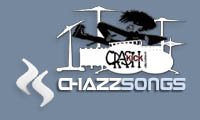
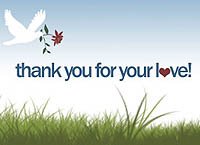








 Tom Moulton was a fashion model on hiatus from the music
business when he visited Fire Island's Botel during a photo shoot. "I got a charge
out of it, all these
Tom Moulton was a fashion model on hiatus from the music
business when he visited Fire Island's Botel during a photo shoot. "I got a charge
out of it, all these 